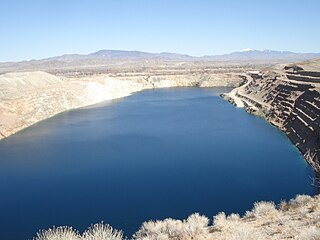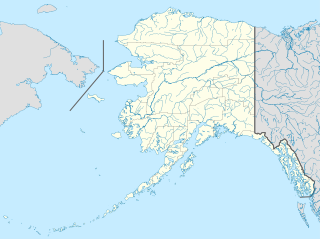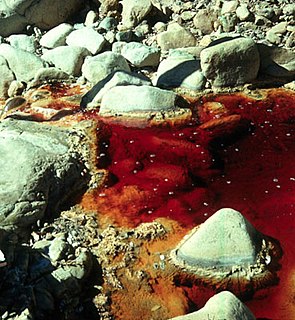 W
WThe Anaconda Copper Mine is an open pit copper mine in Lyon County, Nevada that was owned and operated by the Anaconda Mining Company. It is located adjacent to the town of Yerington. A company town, Weed Heights, was built to support the mining operation which ran from 1952 until 1978.
 W
WThe Berkeley Pit is a former open pit copper mine located in Butte, Montana, United States. It is 1 mi (1,600 m) long by 1⁄2 mi (800 m) wide with an approximate depth of 1,780 feet (540 m). It is filled to a depth of about 900 feet (270 m) with water that is heavily acidic, about the acidity of Coca-Cola, lemon juice, or gastric acid. As a result, the pit is laden with heavy metals and dangerous chemicals that leach from the rock, including copper, arsenic, cadmium, zinc, and sulfuric acid.
 W
WThe Bingham Canyon Mine, more commonly known as Kennecott Copper Mine among locals, is an open-pit mining operation extracting a large porphyry copper deposit southwest of Salt Lake City, Utah, in the Oquirrh Mountains. The mine is the largest man-made excavation, and deepest open-pit mine in the world, which is considered to have produced more copper than any other mine in history – more than 19 million tons. The mine is owned by Rio Tinto Group, a British-Australian multinational corporation. The copper operations at Bingham Canyon Mine are managed through Kennecott Utah Copper Corporation which operates the mine, a concentrator plant, a smelter, and a refinery. The mine has been in production since 1906, and has resulted in the creation of a pit over 0.75 miles (1,210 m) deep, 2.5 miles (4 km) wide, and covering 1,900 acres. It was designated a National Historic Landmark in 1966 under the name Bingham Canyon Open Pit Copper Mine. The mine experienced a massive landslide in April 2013 and a smaller slide in September 2013.
 W
WThe Black Thunder Coal Mine is a surface coal mine in the U.S. state of Wyoming, located in the Powder River Basin which contains one of the largest deposits of coal in the world. Black Thunder is the second most productive mine in the United States, providing the U.S. with eight percent of its coal supply. In 2007, the mine produced 86,196,275 short tons of coal, nearly 20 percent of Wyoming's total coal production, and higher than 23 other individual coal producing states.
 W
WBlackbird mine was a large cobalt mining facility in Lemhi County, Idaho, United States.
 W
WCentralia Coal Mine is an open-pit coal mine, owned by the Canadian-based TransAlta Corporation. The mine is currently shut down. Also referred to as the TransAlta Centralia Mining (TCM) operation, the coal mine is located approximately 5 miles (8 km) northeast of the city of Centralia, in Lewis County, in the US state of Washington. Together with Centralia Power Plant, it was bought in May 2000 by TransAlta for $554 million – $101 million for the mine and $453 million for the power plant.
 W
WThe Chino Mine, also known as the Santa Rita mine, is an open-pit porphyry copper mine located in the town of Santa Rita, New Mexico 15 miles (24 km) east of Silver City. The mine was started as the Chino Copper Company in 1909 by mining engineer John M. Sully and Spencer Penrose, and is currently owned and operated by Freeport-McMoRan Inc. subsidiaries. The area where the mine is located is at an average elevation of 5,699 feet (1,737 m).
 W
WCortez Gold Mine is a large gold mining and processing facility in Lander and Eureka County, Nevada, United States, located approximately 75 miles (120 km) southwest of Elko. It is owned as a joint venture between Barrick Gold Corporation (61.5%) and Newmont Corporation (38.5%), operated by Barrick, and comprises the Pipeline, Crossroads, and Cortez Hills open pit mines; and the Cortez Hills underground mine. Ore from the mines is treated at an oxide mill at the site and on leach pads, while refractory ore is shipped to Barrick’s Goldstrike operation for processing.
 W
WThe Cripple Creek & Victor Gold Mine, formerly and historically the Cresson Mine, is an active gold mine located near the town of Victor, in the Cripple Creek mining district in the US state of Colorado. The richest gold mine in Colorado history, it is the only remaining significant producer of gold in the state, and produced 322,000 troy ounces of gold in 2019, and reported 3.45 million troy ounces of Proven and Probable Reserves as at December 31, 2019. It was owned and operated by AngloGold Ashanti through its subsidiary, the Cripple Creek & Victor Gold Mining Company (CC&V), until 2015, when it sold the mine to Newmont Mining Corporation.
 W
WThe El Dorado Gold Mine is a gold mine and tourist attraction at the unincorporated community of Fox, near Fairbanks, Alaska. Founded in the early 1900s, the El Dorado mine underwent a gradual transformation in the latter half of the 20th century into an informational mine and tour destination. The El Dorado Gold Mine is owned by Alaska Riverways, Inc., and is located 10 miles north of Fairbanks on the Elliot Highway.
 W
WThe Fort Knox Gold Mine is an open pit gold mine, 9 mi (14 km) east of Fox in the Fairbanks mining district of Alaska. It is owned and operated by Toronto-based Kinross Gold. Originally staked in 1913, after very minor mining at the location the property sat idle until being restaked in 1980. Following the initial exploration discovery in 1987, in 1992 the project was purchased by Amax Gold, which brought the mine to production. Amax Gold merged with Kinross Gold in 1998.
 W
WHill-Annex Mine State Park is a state park of Minnesota, United States, interpreting the open-pit mining heritage of the Mesabi Range. The park is located north of the city of Calumet, in Itasca County, Minnesota. The park provides access to fossil material exposed by mining from the Cretaceous era Coleraine Formation.
 W
WThe Homestake Mine was a deep underground gold mine located in Lead, South Dakota. Until it closed in 2002 it was the largest and deepest gold mine in North America. The mine produced more than forty million troy ounces of gold during its lifetime. This is about 70.75 m3 or a volume of gold roughly equal to 18 677 gallons.
 W
WThe Hull–Rust–Mahoning Open Pit Iron Mine in Hibbing, Minnesota, United States, is the largest operating open-pit iron mine in Minnesota. The pit stretches more than three miles (5 km) long, two miles (3 km) wide, and 535 feet (163 m) deep. It was established in 1895 and was one of the world's first mechanized open-pit mines.
 W
WIron Mountain Mine, also known as the Richmond Mine at Iron Mountain, is a mine near Redding in Northern California, US. Geologically classified as a "massive sulfide ore deposit", the site was mined for iron, silver, gold, copper, zinc and pyrite intermittently from the 1860s until 1963. The mine is the source of extremely acidic mine drainage which also contains large amounts of zinc, copper and cadmium. One of America's most toxic waste sites, it has been listed as a federal Superfund site since 1983.
 W
WThe Lavender Pit is a former open pit copper mine near Bisbee in Cochise County, Arizona, United States. It is located near the famous Copper Queen Mine. The Lavender Pit was named in honor of Harrison M. Lavender (1890–1952), who as Vice-President and General Manager of Phelps Dodge Corporation, conceived and carried out this plan for making the previously unprofitable low-grade copper bearing rock of the area into commercial copper ore.
 W
WThe Midnite Mine is an inactive former uranium mine in the Selkirk Mountains of the American state of Washington that operated from 1955-1965 and again from 1968-1981. Located within the reservation of the Spokane Tribe of Indians, it is approximately 8 miles (13 km) from Wellpinit, Stevens County. The mine was listed as a Superfund site under the Comprehensive Environmental Response, Compensation, and Liability Act of 1980 (CERCLA) on May 11, 2000. In addition to elevated levels of radioactivity, heavy metals mobilized in acid mine drainage pose a potential threat to human health and the environment.
 W
WMountain Iron Mine is a former mine in Mountain Iron, Minnesota, United States. Opened in 1892, it was the first mine on the Mesabi Range, which has proved to be the largest iron ore deposit ever discovered. Mining operations at the site ceased in 1956. The bottom of the open-pit mine has filled with water but its dimensions are readily visible. The city maintains an overlook in Mountain Iron Locomotive Park.
 W
WThe Mountain Pass Mine is an open-pit mine of rare-earth elements on the south flank of the Clark Mountain Range, just north of the unincorporated community of Mountain Pass, California, United States. The mine once supplied most of the world's rare-earth elements. Owned by MP Materials, it is the only rare earth mining and processing facility in the United States.
 W
WThe New Cornelia mine is a currently inactive open-pit copper mine in Pima County, Arizona, United States. It was the only productive mine in the Ajo mining district, and is located just outside the town of Ajo, which was built as a company town to serve the New Cornelia mines. The roughly circular pit is one and a half miles across at its widest point, and 1,100 feet deep at the center.
 W
WThe North Antelope Rochelle Mine is the largest coal mine in the world. Located in Campbell County, Wyoming, about 65 miles south of Gillette, it produced 109.3 million tons of coal in 2015.
 W
WThe Office of Surface Mining Reclamation and Enforcement (OSMRE) is a branch of the United States Department of the Interior. It is the federal agency entrusted with the implementation and enforcement of the Surface Mining Control and Reclamation Act of 1977 (SMCRA), which attached a per-ton fee to all extracted coal in order to fund an interest-accruing trust to be used for reclamation of abandoned mine lands, as well as established a set environmental standards that mines must follow while operating, and achieve when reclaiming mined land, in order to minimize environmental impact. OSMRE has about 500 employees, who work in either the national office in Washington, DC, or of the many regional and field offices.
 W
WThe Red Dog mine is a large zinc and lead mine in a remote region, about 80 miles (130 km) north of Kotzebue, which is owned and operated by the Canadian mining giant Teck Resources. It is located within the boundaries of the Red Dog Mine census-designated place in the Northwest Arctic Borough of the U.S. state of Alaska.
 W
WThe Reed Gold Mine is located in Midland, Cabarrus County, North Carolina, and is the site of the first documented commercial gold find in the United States. It has been designated a National Historic Landmark because of its importance and listed on the National Register of Historic Places
 W
WThe Rio Tinto Boron Mine in Boron, California is California's largest open-pit mine and the largest borax mine in the world, producing nearly half the world's borates. Ore reserves are sufficient for production through at least 2050. It is operated by the Borax division of the Rio Tinto Group.
 W
WThe Round Mountain Gold Mine is an open pit gold mine in Round Mountain, Nevada. The mine is operated and owned by Kinross Gold.
 W
WRuggles Mine is an open-pit mine that was turned into a tourist attraction but is now closed and was recently sold.The mine is located 40 miles (64 km) northwest of Concord, New Hampshire, in the town of Grafton, a short distance from Route 4 at the village green. The spacious pit includes tunnels and underground chambers, some of which are filled with water. Visitors were allowed to keep any of the various minerals that were found on the mine floor or that could be hammered loose from the walls of the pit.
 W
WThe Summitville mine was a gold mining site in the United States, located in Rio Grande County, Colorado 25 miles (40 km) south of Del Norte. It is remembered for the environmental damage caused in the 1980s by the leakage of mining by-products into local waterways and then the Alamosa River.
 W
WThe Surface Mining Control and Reclamation Act of 1977 (SMCRA) is the primary federal law that regulates the environmental effects of coal mining in the United States.